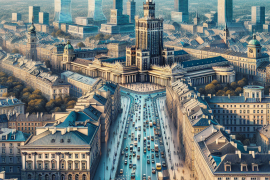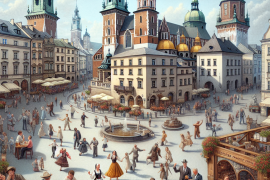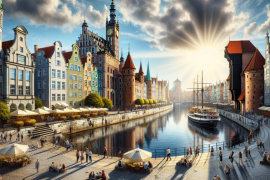
Diving into Polish mythology, we find an incredible collection of gods, mythical creatures, and epic stories that really showcase Poland’s cultural heritage. Take Perun, the powerful thunder god, or the mysterious forest spirits called the Leshy – these characters give us a peek into what the Polish people have valued and believed in over the years.
Looking into these ancient myths and legends, we might just learn something about the Polish spirit and how they’ve stayed strong through tough times. This journey through mythology isn’t just educational; it’s also really interesting, offering us a chance to get to know the Polish culture on a deeper level, in a way that feels like we’re having a chat over coffee.
The Pantheon of Slavic Deities
Slavic mythology showcases a fascinating array of gods and goddesses, shaping the spiritual and cultural beliefs of the region. At the heart of this mythological system lies Perun, the god of thunder. He plays a crucial role, not just as a weather deity, but also as a symbol of law, order, and warfare. This reflects how ancient Slavic societies valued the forces of nature and the importance of maintaining harmony and structure in their communities. Perun’s significance is evident in rituals and stories that highlight his power and authority in the skies.
On the other side, we have Veles, the god associated with the earth, waters, and the underworld. Veles represents the endless cycle of birth, death, and rebirth, underscoring the Slavic people’s deep connection and respect for the land and its cycles. This connection is not just spiritual but also practical, as it influenced agricultural practices and societal norms.
The relationship between Perun and Veles is particularly intriguing. They are often depicted in a state of conflict, symbolizing the natural tension between the sky and the earth, life and death. This dynamic relationship illustrates the Slavic belief in balance and harmony within the universe, where opposing forces are essential for the sustenance of life and the natural order.
Understanding these deities helps us appreciate the complexity of Slavic mythology. It’s not just about the gods themselves but what they represent – the interplay between nature, society, and the human condition. Through their stories and the rituals dedicated to them, we gain insights into how ancient Slavs viewed the world around them and their place within it.
In a way, these myths are more than just ancient tales. They offer a window into understanding the values, fears, and hopes of the Slavic people. By exploring these stories, we’re not just learning about mythical figures; we’re uncovering layers of human history and the timeless quest to make sense of the natural and spiritual world.
Legendary Creatures of the Forest
In Slavic mythology, forests are not just about trees and wildlife; they’re home to fascinating legendary creatures that reflect the ancient culture’s deep connection with nature.
One of the most interesting of these creatures is the Leshy. Think of the Leshy as the ultimate protector of the forest, but with a twist – it can change shape. Imagine walking through the woods and a tree suddenly turns into a creature or a small leaf becomes a guardian before your eyes. This ability to morph shows how Slavic myths see the forest as a place full of surprises, both welcoming and dangerous.
Another captivating creature is the Rusalki, water nymphs that are believed to live in the forests’ lakes and rivers. They symbolize the link between water and land, reminding us of the Slavic culture’s respect for all parts of the natural world. Just picture these nymphs as the guardians of water, ensuring that the forests stay lush and vibrant.
These mythical beings from Polish folklore not only add a layer of enchantment to the natural landscape but also teach us about the importance of living in harmony with our environment. They serve as reminders of the beauty and complexity of nature, encouraging us to appreciate and protect it.
In a way, learning about these creatures can inspire us to explore our own connections with nature. Whether it’s through outdoor adventures, supporting conservation efforts, or simply enjoying the beauty of a local park, there are many ways we can engage with the natural world.
For those interested in delving deeper into Slavic mythology, there are books and documentaries that explore these legends in more detail, offering a window into a world where nature and mythology intertwine.
Heroes and Heroines in Folk Tales
Diving into Polish folklore, we uncover a world filled with heroes and heroines who capture the essence of ancient Slavic society’s values and struggles. Unlike the mystical creatures that roam the forests, these characters often come from simple beginnings. Yet, they stand out for their courage, wisdom, and honesty. They guide their communities, showing that being smart and morally upright is more crucial than mere physical strength.
For example, the legend of the Wawel Dragon highlights not just a battle but the cleverness required to defeat a fearsome enemy. Similarly, the tale of the mermaid of Warsaw isn’t just a story about a mythical creature; it’s about loyalty and protecting those you love. These stories do more than entertain. They pass down the wisdom and moral guidelines of previous generations, showing what people valued and aspired to be.
In discussing these tales, it’s essential to recognize their role beyond simple bedtime stories. They are cultural treasures, preserving the ethos of their time. They remind us that heroes come in many forms, often showing strength not through force but through their actions and choices. This perspective encourages us to look beyond the surface and appreciate the deeper qualities that make someone truly heroic.
In a world rich with history and folklore, Polish tales stand out as vivid examples of how stories can shape and reflect societal norms. They teach us that heroism is accessible to everyone, regardless of their origins, and that the greatest victories often require brains, heart, and courage. Through these narratives, we connect with the wisdom of the past and learn lessons that remain relevant today.
Sacred Sites and Their Myths
Polish folklore is filled with stories about sacred sites, ranging from mysterious forests to peaceful lakes. These places are not just settings for tales; they connect us to the spiritual beliefs of ancient Slavs before the spread of Christianity in Poland. Scholars have found that natural landmarks were often viewed as spiritually significant. For example, mountains were considered homes of gods, rivers symbolized life and renewal, and forests were seen as places full of magic.
Let’s dive a bit deeper. Take mountains, for instance. They were not just big piles of rocks for ancient Slavs; they believed mountains were where gods lived. Imagine seeing a towering mountain and thinking it’s so majestic that divine beings must reside there. It’s a powerful way of recognizing the beauty and mystery of nature. Similarly, rivers were more than water flowing from one place to another; they represented the flow of life itself, constantly moving and renewing. And forests? They were the ultimate symbol of mystery and magic, places where anything could happen.
This connection to nature was central to Slavic spirituality, showing a deep respect for the world around them. It’s a reminder of how every part of nature was seen as alive and filled with divine presence.
In today’s world, we can learn from these ancient beliefs by appreciating the natural landmarks around us. Maybe it’s a hiking trip to the mountains to feel closer to the sky or a quiet moment by a river to reflect on life’s continuous flow. And when walking through a forest, perhaps we can allow ourselves to feel a bit of that old magic and wonder.
The Influence of Polish Mythology
Polish mythology plays a crucial role in shaping the country’s culture, language, and identity. This mythology is not just a collection of stories about gods and legendary heroes. It’s a vital part of Poland’s history and daily life. For example, many Polish idioms and expressions come from these ancient tales, showing how deeply these stories are embedded in the Polish language.
The influence of these myths extends beyond language. They have been a source of national pride, especially during tough times when Poland faced foreign rule or political turmoil. Think of it as a treasure trove of stories that kept the Polish spirit alive. These stories reminded people of their roots and gave them a sense of unity and resilience.
Let’s talk about how these myths have impacted arts and literature in Poland. Artists and writers have drawn inspiration from these tales for centuries, creating works that explore themes of heroism, nature, and spirituality. These works have helped to keep the myths alive, passing them from one generation to the next.
Moreover, Polish mythology has fostered a strong sense of cultural continuity. Even today, these ancient stories connect Poles to their ancestors, creating a bridge between the past and the present. This connection is celebrated in festivals and traditions that keep the mythology alive in the hearts of the people.
Conclusion
Polish mythology is full of interesting gods, magical creatures, brave heroes, and special places that mean a lot to Poland’s culture and spiritual life. It includes a bunch of Slavic gods and legendary beings from the forest that show how important nature and good values are to people. These stories help us understand what Polish folks have thought and gone through over time, connecting them to the wider world of Slavic and European myths.
Talking about these myths is like sharing stories around a campfire. They bring us closer to understanding not just Poland, but also the shared stories that bind us all together in Europe. It’s a fun and meaningful way to see how people from the past made sense of the world around them.






Comments are closed.